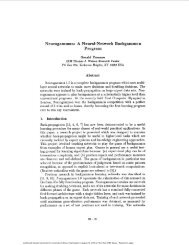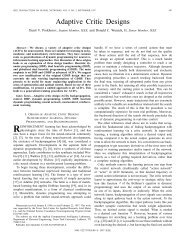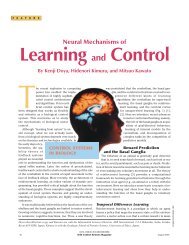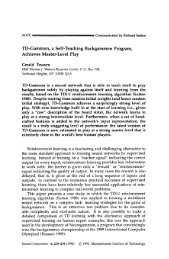Neural-Network-Based State Feedback Control of a ... - IEEE Xplore
Neural-Network-Based State Feedback Control of a ... - IEEE Xplore
Neural-Network-Based State Feedback Control of a ... - IEEE Xplore
You also want an ePaper? Increase the reach of your titles
YUMPU automatically turns print PDFs into web optimized ePapers that Google loves.
JAGANNATHAN AND HE: NN-BASED STATE FEEDBACK CONTROL OF A NONLINEAR DISCRETE-TIME SYSTEM 2081<br />
cause both and are bounded,<br />
is bounded to . In Theorem 2, we show that is<br />
bounded, i.e., the state is bounded to the virtual control<br />
signal . Thus, the state is bounded to the desired<br />
virtual control signal .<br />
Remark 10: Feedforward NNs are used as building blocks<br />
both in tracking error and adaptive-critic-based NN controllers.<br />
In the case <strong>of</strong> the first control methodology, tracking error is<br />
used as a feedback signal to tune the NN weights online. The<br />
only objective there is to reduce the tracking error, and therefore,<br />
no performance criterion is set. To the contrary, adaptive<br />
critic NN architectures use reinforcement learning signal generated<br />
by a critic NN. The critic signal can be generalized using<br />
complex optimization criteria including the variant <strong>of</strong> the standard<br />
Bellman equation. As a consequence, an adaptive critic<br />
NN architecture results in a considerable computational overhead<br />
due to the addition <strong>of</strong> a second NN for generating the<br />
critic signal. In the proposed work, a single NN is used to generate<br />
a critic signal for tuning the two action-generating NN<br />
weights. As a result, computational complexity is slightly reduced<br />
but still requires three NN when compared to two NN in<br />
the case <strong>of</strong> tracking-error-based NN controller. Moreover, all the<br />
NNs are tuned online compared to standard work in the adaptive<br />
critic NN literature [11]–[13]. Lyapunov-based analysis is<br />
demonstrated for stability whereas available adaptive critic papers<br />
use purely numerical simulation results without any analytical<br />
pro<strong>of</strong>s. Simulation results are presented in Section V to<br />
justify the theoretical conclusions.<br />
Fig. 3. Performance <strong>of</strong> a standard controller without NN.<br />
V. SIMULATIONS<br />
The purpose <strong>of</strong> the simulation is to verify the performance<br />
<strong>of</strong> the adaptive critic NN controller. Two cases are considered.<br />
The first is to apply the proposed adaptive critic NN controller<br />
to a nonlinear system. Then, a practical nonlinear system [e.g.,<br />
emission control in spark ignition (SI) engine] is considered and<br />
the proposed approach is employed.<br />
Example 1 (Adaptive Critic <strong>Control</strong>ler for Nonstrict <strong>Feedback</strong><br />
Nonlinear System): The control objective is to make the<br />
state follow the desired trajectory . The proposed<br />
adaptive critic NN controller is used on the following nonlinear<br />
system, given in nonstrict feedback form:<br />
(82)<br />
(83)<br />
where , are the states and is<br />
the control input. Note that both and include state<br />
.<br />
The reference signal was selected as<br />
, where and with a sampling interval <strong>of</strong><br />
. The total simulation time is taken as 250 s. The<br />
gains <strong>of</strong> the standard proportional controller are selected a priori<br />
and using (78) and (79).<br />
Fig. 4.<br />
<strong>Control</strong> input.<br />
NN1 , NN2 , and critic NN3 each<br />
consists <strong>of</strong> 15 nodes in the hidden layer. For weight updating,<br />
the learning rates are selected as , , and<br />
. All the initial weights are selected at random over<br />
an internal <strong>of</strong> and all the activation functions used are hyperbolic<br />
tangent sigmoid functions.<br />
Figs. 3 and 4 present the performance <strong>of</strong> the standard proportional<br />
controller alone from the adaptive critic controller and associated<br />
control input, respectively, without the NNs included.<br />
From Fig. 3, it is clear that the tracking performance has deteriorated<br />
in comparison with Fig. 5 when the NNs were included in<br />
the controller. Fig. 5 illustrates the superior performance <strong>of</strong> the<br />
adaptive critic NN controller. The gains were not altered in both<br />
simulations. Fig. 6 depicts the NN control input that appears<br />
to be sufficiently smooth such that it can be implemented in<br />
today’s embedded system hardware. Because the control input









